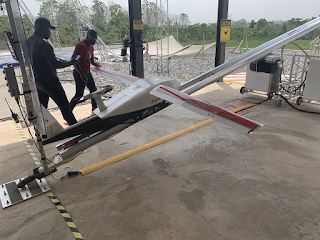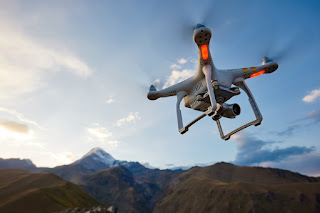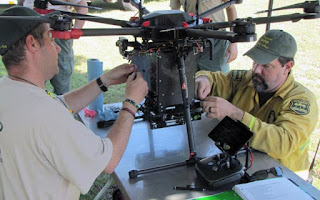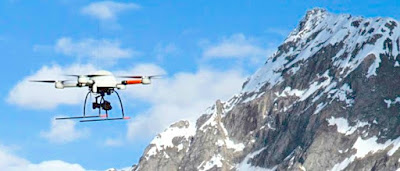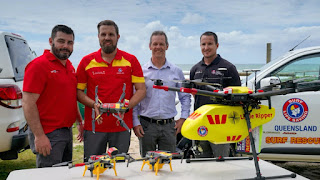Commercial UAV News March 17, 2020
While the positive public perception of drones has
increased over the last five years, real and perceived fears about drones
persist, often restricting progress for good. In the UK (which has dealt with
prison drone deliveries by gangs, a number of near misses, and the December,
2018 Gatwick drone incident which led to flight cancellations and the stranding
of thousands of passengers), there is a definite mistrust of drones evidenced
by the April 2019 PwC research study finding less than a third of those polled
in the UK feeling positive about drone technology. The same is true in the
United States where a December 2019 Hawthorn Group research study found 68%
“concerned” about the safety of drones, with only 7% “not concerned at all.”
While 51% supported drone delivery, 49% thought it was “too dangerous” with 71%
having privacy concerns.
While the public benefit of drones is well documented
even before the newly permitted commercial use of drones by the FAA, there is
still an uphill battle to win the public over on the truth that despite the
risks that come with drones, there is a huge upside. It is becoming clearer day
by day that drones not only have the potential for simplifying our lives, but
also in making our world safer. The use of drones by police to track criminals,
by firefighters to get a better perspective on fires, and by municipalities to
do safety reviews of water tanks, oil pipelines and electrical lines is
evidence of the public safety impact drones can have – and we are only in the
infant stages of the public use of this emerging technology.
The recent outbreak of the novel corona virus (COVID-19),
requiring people to be quarantined to attempt to slow down this worldwide
pandemic, opens up another potentially huge public benefit of drones. While
commercial drone delivery is just beginning in the United States, imagine the
potential public health benefits of drones delivering medical supplies and food
to quarantined individuals, hospitals or government run facilities. Drones
could potentially answer the question of how quarantined individuals could
sustain themselves over an extended quarantine, thereby also hopefully reducing
the hoarding we have seen across the U.S.
I experienced the vast potential for drones recently when
I was privileged to visit a Zipline Center just north of Suhum, Ghana. Zipline
is a for profit corporation established in the San Francisco area in 2014 which
is already having a huge impact on public health in Africa. Their 2 meter long
Styrofoam unmanned aircraft with a wingspan of 3.3 meters are saving lives in
Rwanda and Ghana through contracts with those countries’ health organizations
to deliver blood, vaccines and other medical supplies to remote areas difficult
to access by road.
I was first exposed to Zipline at the AUVSI (“Association
for Unmanned Vehicles Systems International”) Conference in Denver in May 2018
where the company was one of the recipients of the Inaugural AUVSI XCELLENCE
Humanitarian Award for their work in medical supply delivery in Rwanda. As I am
currently based in Accra, Ghana working as the Director for West Africa on a
project for Pepperdine School of Law’s Global Justice Institute, I became aware
of Zipline’s award of a four-year $12,000,000 contract with Ghana’s National
Health Service in December of 2018. As Zipline’s first “center” in Ghana is
located in Omenako, Ghana which is about an hour and a half drive north of
Accra just past Suhum, I obtained permission from Daniel Marfo, the General
Manager of Zipline International, to have a tour and interview some of its
staff.
Omenako is one of four Zipline Centers in Ghana and
covers the entire Eastern Region. It began operation on April 19, 2019, with
the Mampong Center opening on October 19, 2019 and covering the majority of the
Ashanti Region as well as Brong-Ahofo Region. These two facilities are
currently servicing over 200 medical facilities with each doing approximately
35 deliveries per day, 7 days a week. The Wale Wale Center serving the Northern
Region is set to open in March, 2020, with the Sefwi Wiawso Center serving the
Western Region set to open in April. The goal is for each center to service 500
Health Facilities each within the next 4 years.
All manufacturing of this Styrofoam unmanned winged
aircraft is done at Zipline’s manufacturing facility in Davis, California,
including its lithium-ion battery which doubles as a black box downloading data
from the previous flight while being recharged. Zipline’s “Robin” drone has an
80 km range while the newer “Sparrow” has a range of 120 km flying at 400-500
meters at 100 km/hr. Medical supplies are placed in a composite compartment
with a capacity of up to 1.75 kg or almost 4 lbs. If blood or other temperature
sensitive supplies are being delivered, ice packs are placed around the product
which is then placed in a bubble lined cardboard box with a paper parachute,
both of which are weather resistant.
I was able to witness a delivery firsthand when I visited
the Omenako Center on February 27th. Once a health facility in Ghana requests
service to begin, and Zipline is able to visit and establish coordinates for a
drop zone, they get a flight plan approved by the Ghana Civil Aviation
Authority and then once approved, they are ready to fly to that facility. The
delivery I witnessed was medical supplies going to the Pakro Health Center
which by road would take at least an hour and a half not taking into account
bad traffic or an accident. If it was the rainy season, the road to Pakro could
easily be flooded out making delivery difficult if not impossible. Other health
facilities are across Lake Volta which means far longer transport by road as
they need to cross by ferry. A Zipline drone can deliver a package to Pakro in
25 minutes, rain or shine, night or day. Imagine what that time savings could mean
to a patient who needs a blood transfusion for example – literally a matter of
life and death.
Once the delivery was called out on the loudspeaker, the
medical supplies already packed were brought to the window of the temperature and
environmentally controlled supply center and then given to the flight personnel
– in this case it was John Baptist, the Flight Lead at Omenako. Once John
packed the box into the frame of a Robin drone, it was brought to the catapult
style launching pad that is unique to Zipline. Once placed on the track, the
wing is put in place, the battery is connected, and they are ready to go within
5 minutes. Almost immediately after the aircraft was put together, its double
propellers began whirring and the aircraft literally “zipped” away with vital
medical supplies for Pakro.
I was then excited to hear over the loudspeaker that a
drone was approaching from another mission. When a Zipline drone gets to its
destination, it drops the package in the previously designated drop zone, then
immediately turns around and returns to base. As it approaches the landing
area, it flies between 2 steel girders and is caught by a cable and then
recovered nose down once it stops swinging. Below are videos of both takeoff
and landing to give the reader a sense of this amazing and efficient delivery
system designed by Zipline.
What makes the Zipline operation even more impressive is
the cost savings. While the $12,000,000 contract drew some criticism in Ghana
when it was signed due to a gap in understanding of the program, that is
diminishing due to Zipline’s impressive performance over the first 11 months of
operation. Truck deliveries which need refrigeration are particularly expensive
in Ghana. Zipline, in compliance with the requirements of the NHS under their
contract, stocks blood, vaccines (both in modern refrigerator units), and other
medical items that can run out at remote health facilities. Facilities can also
make special orders for items needed. The contract covers all services for NHS
facilities across Ghana. The facilities do not pay Zipline for their services
but do pay for supplies from the National Blood Service who they pay directly.
This is an exciting opportunity to use drones for good
around the world to save lives and money in areas that are difficult to reach
by road. Zipline is currently part of the UAS Integration Pilot Program (IPP)
in the United States, partnering with the North Carolina Department of
Transportation with operations scheduled to begin in June of this year, which
will hopefully lead to Zipline service for remote parts of the US in the near
future. Zipline is only one example in the potential public benefit of drones
in the commercial sector.
All of this does not mean we don’t deal with the real
issues of terrorism, privacy and safety, but it is my strong belief that (like
other technological breakthroughs, including the internet) although there are
definite risks, the benefits of drones dwarf them even in this early stage of
widespread use. The Hawthorn Group research cited above found that 93% of
Americans studied wanted regulation of drones. I totally agree. Fully
researched and tested regulation and tort law in the drone arena are the answer
to fear. I therefore would call upon the FAA to keep pressing on to the goal of
solid and expansive drone regulation, and the Uniform Law Commission to not
give up on its efforts to encourage the Drafting Committee to work to balance
the interests of property rights advocates with the commercial drone industry
in finalizing a workable Tort Law Relating to Drones Act that can be approved
and distributed to States as soon as possible – if not by the July Annual
Meeting in Wisconsin, then by the 2021 Meeting in New York next July.
Do you have a story of drones coming to the rescue or
assisting your agency? Please share in the comments.


